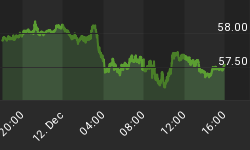HIGHLIGHTS in "Global Watch - The Gold Forecaster"
Silver - EDR.V, SSRI, PAAS, SIL, HL, CDE / Platinum
SHARES: HUI, NEM, FCX, GFI, HMY, DROOY, NG, AEM, VGZ
Features Below: -
Market Action / Short-term forecasts across the Board!
- Comex positions.
- Gold's independence from currencies - why will gold rise now.
- Refining capacity & supplies insufficient for future demand.
- Prospects for the U.S. $ and Prospects for the Euro.
- Prospects for the US $ / DJIA / 10-Year Bond / CRB / Gold : Oil Ratio Under 7.5! / Gold : Silver Ratio.
- Technical Analysis of the Gold Price: Long/Short term -U.S. $
- Summary: The present Gold Price Drivers.
- International Gold Markets / Focus on Euro, Euro Gold Price
Special Offer! - Trial Subscription 3 months for $99 - go to www.goldforecaster.com
Do you want to receive your own copy of "Gold - The Weekly Global Perspective" [excerpts from the FULL version ] - Send your e-mail address to: gold-authenticmoney@iafrica.com
Excepts from the "Global Watch - The Gold Forecaster":
Gold's Independence from Currencies - Why will gold rise now? Many continue to be puzzled by the moves in the gold price both in Euros and in the U.S. $. And the price has prompted many to turn to the formulae they usually rely on to look at the gold price. Some have recognised that gold has moved into a separate category of its own, but many just cannot get past their own gold formulae, such as 'gold moves in an opposite direction to the U.S.$'. Here is an example of an authoritative U.S. definition of the gold price. Gold will rise if:
Many continue to be puzzled by the moves in the gold price both in Euros and in the U.S. $. And the price has prompted many to turn to the formulae they usually rely on to look at the gold price. Some have recognised that gold has moved into a separate category of its own, but many just cannot get past their own gold formulae, such as 'gold moves in an opposite direction to the U.S.$'. Here is an example of an authoritative U.S. definition of the gold price. Gold will rise if:
- The expected rate of inflation is greater than the expected short-term interest rate cost of holding it. If these expectations are realized, the nominal price of gold will rise by an amount greater than the forgone interest income.
- The currency in which the gold is priced weakens. If each dollar becomes worth less, it will take more of them to claim a given quantity of gold, and the nominal price will rise.
 Please note that the writer, when referring to the gold price actually meant the U.S. $ gold price. But Gold is bought in Rupees, in € and in other currencies too. In each nation where these currencies are the local currency, each market participant assesses its value in terms of that currency. If it rises in Rupees, buyers wait for it to fall, if it fall in Rupees, it presents a buying opportunity. They are not guided by the U.S.$ Gold price.
Please note that the writer, when referring to the gold price actually meant the U.S. $ gold price. But Gold is bought in Rupees, in € and in other currencies too. In each nation where these currencies are the local currency, each market participant assesses its value in terms of that currency. If it rises in Rupees, buyers wait for it to fall, if it fall in Rupees, it presents a buying opportunity. They are not guided by the U.S.$ Gold price.
What is of critical importance is that the gold price has risen in the €, something it has not done significantly for years. Why, because confidence in the € has stumbled. The way forward for the € does not look good, so gold to Europeans is suddenly attractive. They are not particularly concerned with Gold's performance on the U.S. $.
The structural change is that in each currency, gold will be assessed and not with reference to the $! This is why the global approach to the gold market is the one that will understand the future of gold, not a parochial one.
This approach should begin with an assessment of each "Gold related" country's importance to the gold market. Is the U.S. the most important or even the dominant gold market? No, it is a good part of it, but not the part that defines the price. So why should the $ be the definer of the gold price. If a European buys gold because of the weakness of the €, he may pay in U.S. $ but he may pay in €, but he is driven to do so by the performance of the € not the $!
In the above analysis by the U.S. writer, he is right insofar as a U.S. citizen buys gold, but will fail to understand the gold price itself with these measures of influence on gold.
This approach will prove to be the only professional one, from now on, or the ability to profit fully will be compromised. We hope we can be of assistance to you in this?
Interest rates and the oil price
There is no doubt that rising oil prices produces inflation, as the increased costs to companies are passed on through to clients and customers in a 'ripple' effect. Many nations want to control this by pushing interest rates up, lowering the market's ability to carry these higher prices. But oil price rises also act like taxation and pull money out of the consumers pockets. Add this to higher interest rates and the effect on the consumer is to discourage spending. This is where recessions come from.
You can be quite sure that the last thing the Administration wants now is falling growtn and a recession. When this starts to happen, interest rate rises have to stop. With interest rate hikes carefully planned, not only on the present scene, but on the near term future, the Fed must have its eyes carefully focussed on the oil market.
Greenspan and the Fed have acknowledged the damaging efffect recent high oil prices have had on growth, so are fully aware that a breakout of the oil price over $60 and holding there will not simply trim growth, but sag consumer confidence.
A halt to interest rate hikes and even a dropping of these rates comes onto our horizons then. So while we still expect a ¼ point rise in the Fed Funds rate, it could be 'cancelled', should oil prices continue to rise!
India - The Monsoon Progress report and the past year for India.
[With Thanks to Daman Prakash]
Monsoon
The monsoon is so far erratic with affected areas suffering a very unusual hot spell. So far this year Kerala state has received only 58% of its average rainfall by comparison with the average for the southwest monsoon with only (only!) 12.9 cm of rainfall in the past fortnight, this against an average of 31 cm. Over India as a whole, the monsoon so far is 52% below normal.
The past year
- In 2004, (Until July 2004), Gold Imports looked like reaching historic peaks. During this period, Letters of Credit of 360 days on Imports gave Indians an arbitrage advantage as high as 3 to 4%. ( Indian deposit rates wre 5.5% whereas LIBOR for U.S. $ was 1.25 to 1.75%). Thus while international prices were high Indian selling rates were 3% lower. Then (With effect from 9th July 2004, the Reserve Bank of India, destroyed this scheme by reducing the Letters of Credit time limit from 360 days to 91 days. This tightened the Rupee/$ forward by charging 1.5%, so reducing deposit rates from 5.5% to 5%. The scheme was virtually eliminated with U.S. Fed Funds rates rising from 1% to the present 3.25%.
- The Indian Rupee appreciated during that time by [to Indians] a huge 5% to 6% ( From Rs. 46 per dollar to Rs. 43 per dollar) mitigating the dollar based price rises in Gold.
- The R.B.I. didn't allow commercial banks to offer bank loans for the purchase of Gold for almost four decades. Then in 2004 such loans were permitted by the R.B.I. and offered by the banks. As a result, customers can borrow to buy Gold from the Banks. Banks are also aggressively marketing personal loans to consumers to buy gold as they at last feel that such loans are secure.
- The increase in the gold price promoted good levels of gold lending by Government owned Banks and institutions.
 Such loans are now available against the security. Thus Indians, particularly Jewellers took advantage of the new scheme and took huge gold loans to increase their inventory. The international Gold loan rates charged here are as low as 1.75% to 3% per annum compared to bank deposit rate of 5.5% and bank advances rates of 8 to 10%. Further all immovable properties can now serve as collateral, which has helped jewellers to increase their stock. Large amounts of gold were imported under this loan scheme in 2004 and continued to be so even as late as February 2005 and April 2005, when Gold prices fell from their highs. Gold for lending continues to be imported even now.
Such loans are now available against the security. Thus Indians, particularly Jewellers took advantage of the new scheme and took huge gold loans to increase their inventory. The international Gold loan rates charged here are as low as 1.75% to 3% per annum compared to bank deposit rate of 5.5% and bank advances rates of 8 to 10%. Further all immovable properties can now serve as collateral, which has helped jewellers to increase their stock. Large amounts of gold were imported under this loan scheme in 2004 and continued to be so even as late as February 2005 and April 2005, when Gold prices fell from their highs. Gold for lending continues to be imported even now.
This is why the underlying demand for gold in India remains strong, even with prices hitting record levels in Rupee terms during last year. Jewellery and investment demand resulted in Indian imports of 586 tonnes last year (source: GFMS Ltd) while jewellery demand itself was estimated at 518 tonnes, or roughly 20% of the world overall jewellery consumption. When coins and bars are taken into account, India accounted for just fewer than 18% of gold demand last year.
The Global view is the only professional approach!
This last week has seen the € price of gold show more life than it has done in the last few years. It has broken up and out of its € price ceiling and has clearly broken away from the €. This prompted the following questions: -
- Are Europeans a more currency sensitive people and one who are very quick to turn to gold?
- Has Gold risen in U.S.$, or has the U.S.$ fallen in terms of gold as is the case with the €?
- Is the rise a reflection of the change in the pricing of gold?
- Is Gold to now be seen as a 'measure' of currencies themselves?
- Are we seeing a significant structural change in the gold market?
- Or is the present gold price rise a consequence of demand and supply?
- Is Gold is an effective counter to swings in all currencies [not just the $]".
Through our global view of gold, we explain the gold price in different gold-important currencies from both a fundamental and a Technical point of view.

To Subscribe to "Global Watch - The Gold Forecaster", please go to: www.goldforecaster.com
To Subscribe to "Gold - Authentic Money" or "Gold - The Weekly Global Perspective" go to this link: www.authenticmoney.com
















